Kayaking for Beginners: 24 Tips You Should Know
 Kayaking for Beginners: 24 Tips You Should Know
thegearhunt.com
Kayaking for Beginners: 24 Tips You Should Know
thegearhunt.com
It can be both confusing and daunting to jump into a new sport. If you don’t have any experience with paddling or rowing, the first time you settle yourself into the bottom of a kayak might just leave you with the feeling of being a fish out of water. This is especially the case when you haven’t gotten any tips on the sport yet.
We here at The Gear Hunt take pride in giving you all of the know-how and tips regarding how to get the most pleasure from all of your outdoor activities.
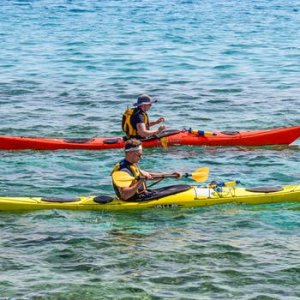 It doesn’t matter if you are looking to tackle some of the best class 4 rapids or if you just want to be able to paddle through a lake that is so calm it will be as if you are gliding on a mirror, there are a few tips for kayaking that you will need to consider before you ever leave the shore. You will find those tips in the next few paragraphs. If you take these into account, you will be able to reap the best benefits from kayaking.
It doesn’t matter if you are looking to tackle some of the best class 4 rapids or if you just want to be able to paddle through a lake that is so calm it will be as if you are gliding on a mirror, there are a few tips for kayaking that you will need to consider before you ever leave the shore. You will find those tips in the next few paragraphs. If you take these into account, you will be able to reap the best benefits from kayaking.
Before You Start
Don’t Dress for the Weather, Do It for the Water
It doesn’t matter if it is a frigid morning near winter of a sweltering afternoon in the dog days of summer, dress as if you will be going in the water. If you might normally wear a wetsuit in the water, do it while you are kayaking. If the water if more appropriate for board shorts, a swimsuit would be ideal.
Invest in Storage Cases that are Waterproof
There isn’t anything that can kill a great kayaking adventure faster than coming back only to realize that your iPhone has been damaged by the water. Press and seal type storage containers might be ok for things like your money and food, but to protect your devices, it is recommended that you use something that is a bit sturdier. You can find things made for this at any outdoor store and even on Amazon.
Learn Safety Practices for Rapids
If you plan on tackling a bit of white water, it is highly recommended that you get up to date with the safety practices for rapids. Your kayak can flip in a heartbeat and you can suddenly find yourself in a situation that is life or death. Every decision you make will count.
If Possible, Rent
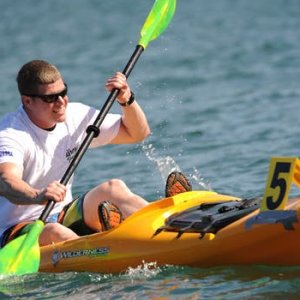 Before you go out and invest in a kayak or any sort of equipment, get a feel for the sport. Services that rent kayaks have gained in popularity through the last decade. Also, make sure that you rent life vests and helmets and not just the paddles and kayak. Safety first.
Before you go out and invest in a kayak or any sort of equipment, get a feel for the sport. Services that rent kayaks have gained in popularity through the last decade. Also, make sure that you rent life vests and helmets and not just the paddles and kayak. Safety first.
Know the Language of the River
Did you know that there are hand gestures and signals that assist kayakers when it comes to communicating with other kayakers? Think about it. When you hit white water, the noise can be astonishingly loud and quite distracting. If you happen to be in a group with other kayakers, it might be more than a bit helpful to learn some of these simple signals.
Know How to Paddle
It is also recommended that you try to get a bit of knowledge as to how to paddle before you leave the shore. You can do this by straddling a chair that has no arms while you hold a hockey or broomstick. Imagine that you are in the kayak and paddle from one side to the other. The way you stroke and hold the paddle will determine the style you have.
Physical Maps
As we mentioned earlier, you might be better off if you leave the electronics either on dry land or in a container that is watertight. Check in with the local visitor’s center or print out a guidebook or map of the area so that you will be able to get your bearings.
What’s the Weather Like?
If you have to kayak through a little bit of rain, it won’t hurt anything. However, if you attempt to do this in a downpour, the cockpit of the kayak will quickly fill with water and this will make it quite unstable. Be sure that you check the weather conditions for where you will be before you even leave home. You might also want to remember that heavy rains from as much as 2 days ago can still make the water more turbulent.
Duct Tape
This is something that no kayaker should ever leave home without. It can come in handy when you run into certain issues. If the shaft of your rod has cracked, tape it up. If you want to secure your gear from rolling around the seat of your kayak, secure it.
On the Water
Sit Straight and Tight
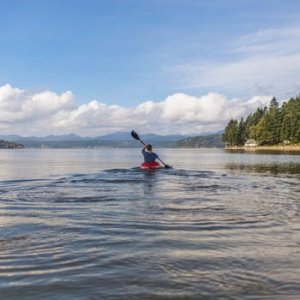 When you are sitting in your kayak with your back supported, the balls of your feet should rest in the foot guides. Alternatively, some kayaks are equipped with pegs as opposed to foot guides. You should point your toes outward and your heels need to be right in the middle of the kayak. Your knees need to be bent a bit up and out to allow for your legs to come into contact with and put pressure on the braces meant for your thighs.
When you are sitting in your kayak with your back supported, the balls of your feet should rest in the foot guides. Alternatively, some kayaks are equipped with pegs as opposed to foot guides. You should point your toes outward and your heels need to be right in the middle of the kayak. Your knees need to be bent a bit up and out to allow for your legs to come into contact with and put pressure on the braces meant for your thighs.
Pace Yourself
Remember that you don’t need to rush from the moment you hit the dock. Enjoy all of the scenery and get a feel for how the kayak feels to your body and how to paddle through the water. Your focus should be more on technique than speed. Slow and steady should be your wheel house.
Remain Alert
Animals and rocks sometimes seem to materialize from thin air. Kayaking isn’t a time when you need to be enjoying your playlist. You need to take advantage of being outdoors and enjoy the playlist that nature provides.
Remain in Contact with Other People
As mentioned above, when you are kayaking as a part of a group, it is always best for everyone to remain in contact. This is especially true if you happen to be traveling down treacherous white water. The typical guideline in cases such as this is that you should always be within earshot of each other.
Move With, Not Against Your Kayak
Have you ever spun while driving a car? If you have, you will know exactly what I mean. Don’t try to fight with your kayak. Just go with it. If your kayak spins, allow it to follow through with its motion and make adjustments as needed. Use the kinetic energy of the kayak to your favor.
Use Binoculars
There aren’t many places from which to watch wildlife that are better than from your kayak. You might want to bring a pair of durable, light binoculars to enhance that ability. Look for binoculars that are portable and resistant to water. Lenses that resist scratches are a plus!
Back on Shore
Get Your Stretching In
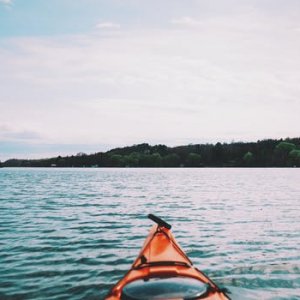 When you get out of your kayak, the odds will be good that you have been sitting in a single position for at least a couple of hours. By the time you get out, your body will more than likely be settled into that position and quite tight. If you want to avoid things like aches and cramps for the remainder of the day, do a bit of light stretching. It can also be helpful to do these stretches before you get into the kayak.
When you get out of your kayak, the odds will be good that you have been sitting in a single position for at least a couple of hours. By the time you get out, your body will more than likely be settled into that position and quite tight. If you want to avoid things like aches and cramps for the remainder of the day, do a bit of light stretching. It can also be helpful to do these stretches before you get into the kayak.
Dry Your Stuff
One of the main rules when it comes to any sort of water activity is to not pack anything away while it is still wet. If you do pack them wet, you can end up with rust, mold, and other unfortunate surprises. If you happen to be in a hurry and don’t have the time to spare, leave all of your gear that is still damp uncovered.
Check Your Gear
Before you get in your car and head off back home, check all of your gear. Make sure that you haven’t gotten any accidental tears, holes, dings, etc. You might want to pay particular attention to the seat of the kayak and your paddle.
On to safety issues.
It doesn’t matter if you are just going for a relaxing paddle at your local pond or if you are headed out for a kayaking trip that is to be filled with adventure and excitement, nothing regarding this sport will ever be as important as safety.
Injuries can and do occur while people are kayaking. Drowning is a true risk, especially when white water is involved. That being said, the actual chances of you obtaining an injury while out in your kayak are really quite low.
Safety should always be your first concern regardless. You will be dealing with a lot of water and if the situation does go sideways, it can do so very badly and very quickly. Due to this, it is absolutely critical that you know about the risks and hazards that are associated with this sport. Always prepare for the worst while expecting the best. Remember that anytime you are in the water, whether in a craft or just swimming, you always need to have an attitude of safety.
Here are a few safety tips that can help you reduce the chances of injury while paddling dramatically.
Life Jacket – Never Leave Shore Without It
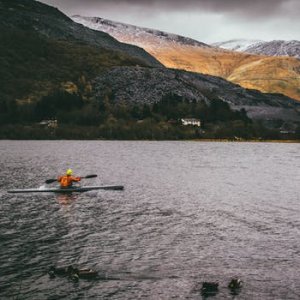 If you ever pay attention to the American Canoe Association, you might be aware of the fact that 48% of fatalities related to kayaking are because the kayakers weren’t wearing life jackets. When it comes to canoeing, that percentage jumps to 85%. What this means is that the risk of your dying while kayaking can be cut neatly in half simply by making sure that every time you go out, you wear your life jacket.
If you ever pay attention to the American Canoe Association, you might be aware of the fact that 48% of fatalities related to kayaking are because the kayakers weren’t wearing life jackets. When it comes to canoeing, that percentage jumps to 85%. What this means is that the risk of your dying while kayaking can be cut neatly in half simply by making sure that every time you go out, you wear your life jacket.
Without a doubt, this is the most critical safety tip regarding kayaks that you will ever get. If you come to find that it is not comfortable to wear the life jacket while you are paddling, you might want to buy a life jacket made specifically for kayaking. These are also called PFDs. This type of life jacket has been designed specifically to allow you to have a greater range of motion and to be less restrictive.
Follow Local Rules for Boating
Before you go out, ensure that you know the local rules for boating. If you will be the only person on a boat, this can be a good thing. This is because not only will you be able to enjoy the solitude and peace, but you also don’t need to worry about any other watercraft. If you aren’t by yourself on the water, there are a couple of things that you might want to consider:
It is critical to both be seen and see. Wear clothing that is bright, equip your paddles with reflective tape, keep your emergency whistle around your neck. This can be especially important if you happen to be kayaking in waters that are busy with motorized boats. If buoys are present, know what their colors mean, and pay attention to the rules of the road when it comes to boating.
Helmet
If you know that you will be traversing rough water, like rivers that are fast flowing, or even white water, it is always a good idea to wear your helmet. There are some places where this might even be a requirement.
Never Drink and Kayak
Mental awareness, physical exercise, and alcohol don’t go well together. Don’t do any sort of drugs or drink alcohol while you are on the water. If you want to pop open a cold one, wait until you have gotten out of the water, set up camp, and are sitting near the campfire watching the sun go down.
Always Let Someone Know
Before heading out to kayak, you should always let a friend or relative know where you will be going and when you should be back. This information should include where you plan to camp, your itinerary, and your location. It should also include anyone in your group and when the trip will end. Once you have done that, you need to stick to the plan.
Check Your Equipment
Unless your equipment and kayak are brand new, it is always a good idea to give everything the once over looking for any wear and tear before you go. Making sure that everything is ok will only make your trip safer.
By following the tips you have found here today, your trip should be one that is both safe and fun. Enjoy!
Sources
- Actively Northwest, The 3 Most Important Kayaking Tips for Beginners
- Brave Hunters, My Basic Kayaking Tips for Beginners
- Seeker, Kayaking for Beginners: What to Know Before You Go
- YouTube, Kayaking and Canoeing for Beginners: Tips on Getting the Kayak into the Water















